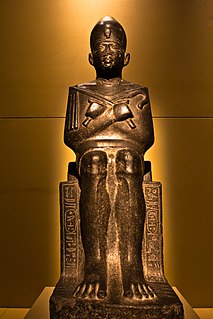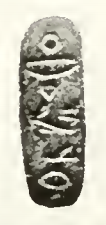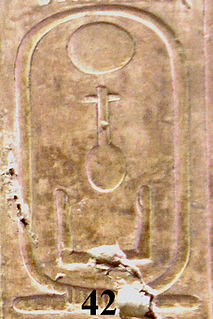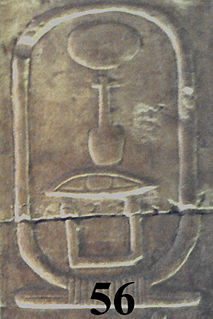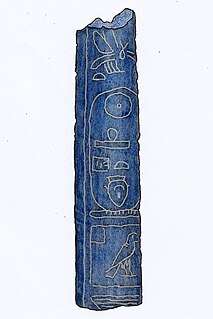| Neferkare Khendu | |||||||||||||||||||||||||
|---|---|---|---|---|---|---|---|---|---|---|---|---|---|---|---|---|---|---|---|---|---|---|---|---|---|
| Neferkare IV | |||||||||||||||||||||||||
 The cartouche of Neferkare Khendu on the Abydos King List. | |||||||||||||||||||||||||
| Pharaoh | |||||||||||||||||||||||||
| Reign | Unknown (Eighth Dynasty?) | ||||||||||||||||||||||||
| Predecessor | Djedkare Shemai? | ||||||||||||||||||||||||
| Successor | Merenhor? | ||||||||||||||||||||||||
| |||||||||||||||||||||||||
Neferkare Khendu (also Neferkare IV) was an ancient Egyptian pharaoh of the Eighth Dynasty during the early First Intermediate Period (2181–2055 BC). According to the egyptologists Kim Ryholt, Jürgen von Beckerath and Darrell Baker he was the sixth king of the Eighth Dynasty. [1] [2] [3]

Ancient Egypt was a civilization of ancient North Africa, concentrated along the lower reaches of the Nile River in the place that is now the country Egypt. Ancient Egyptian civilization followed prehistoric Egypt and coalesced around 3100 BC with the political unification of Upper and Lower Egypt under Menes. The history of ancient Egypt occurred as a series of stable kingdoms, separated by periods of relative instability known as Intermediate Periods: the Old Kingdom of the Early Bronze Age, the Middle Kingdom of the Middle Bronze Age and the New Kingdom of the Late Bronze Age.

Pharaoh is the common title of the monarchs of ancient Egypt from the First Dynasty until the annexation of Egypt by the Roman Empire in 30 BCE, although the actual term "Pharaoh" was not used contemporaneously for a ruler until Merneptah, c. 1200 BCE. In the early dynasty, ancient Egyptian kings used to have up to three titles, the Horus, the Sedge and Bee (nswt-bjtj) name, and the Two Ladies (nbtj) name. The Golden Horus and nomen and prenomen titles were later added.
The Eighth Dynasty of ancient Egypt is a poorly known and short-lived line of pharaohs reigning in rapid succession in the early 22nd century BC, likely with their seat of power in Memphis. The Eighth Dynasty held sway at a time referred to as the very end of the Old Kingdom or the beginning of the First Intermediate Period. The power of the pharaohs was waning while that of the provincial governors, known as nomarchs, was very important, the Egyptian state having by then effectively turned into a feudal system. In spite of close relations between the Memphite kings and powerful nomarchs, notably in Coptos, the Eighth Dynasty was eventually overthrown by the nomarchs of Heracleopolis Magna, who founded the Ninth Dynasty. The Eighth Dynasty is sometimes combined with the preceding Seventh Dynasty, owing to the lack of archeological evidence for the latter which may be fictitious.
Neferkare Khendu's name is attested on the Abydos King List (number 45), a king list dating to the Ramesside-era, and is absent from the Turin canon as a large lacuna in this document affects most kings of the 7th/8th Dynasty. [1]

The Abydos King List, also known as the Abydos Table, is a list of the names of seventy-six kings of Ancient Egypt, found on a wall of the Temple of Seti I at Abydos, Egypt. It consists of three rows of thirty-eight cartouches in each row. The upper two rows contain names of the kings, while the third row merely repeats Seti I's throne name and praenomen.

The Nineteenth Dynasty of Egypt is classified as the second Dynasty of the Ancient Egyptian New Kingdom period, lasting from 1292 BC to 1189 BC. The 19th Dynasty and the 20th Dynasty furthermore together constitute an era known as the Ramesside period. This Dynasty was founded by Vizier Ramesses I, whom Pharaoh Horemheb chose as his successor to the throne.

The Turin King List, also known as the Turin Royal Canon, is an ancient Egyptian hieratic papyrus thought to date from the reign of Pharaoh Ramesses II, now in the Museo Egizio in Turin. The papyrus is the most extensive list available of kings compiled by the ancient Egyptians, and is the basis for most chronology before the reign of Ramesses II.

No attestation is firmly attributable to Neferkare Khendu beyond the Abydos king list, although a cylinder seal inscribed with the cartouche Ḫndy, "Khendy", has been tentatively attributed to him by the egyptologist Henri Frankfort in 1926. [2] [4] [5] Modern scholarship has shown however that the cartouche on the seal is most likely to read "Khamudi", name of the last king of the Hyksos, and furthermore that this cartouche was inserted on the seal as a space filler rather than as an explicit reference to this king. [6] The seal is now in the Petrie Museum, catalog number UC 11616. [6]

Henri "Hans" Frankfort was a Dutch Egyptologist, archaeologist and orientalist.

Khamudi was the last Hyksos ruler of the Fifteenth Dynasty of Egypt. Khamudi came to power in 1534 BC or 1541 BC, ruling the northern portion of Egypt from his capital Avaris. His ultimate defeat at the hands of Ahmose I, after a short reign, marks the end of the Second Intermediate Period.

The Hyksos were a people of diverse origins, possibly from Western Asia, who settled in the eastern Nile Delta some time before 1650 BC. The arrival of the Hyksos led to the end of the Thirteenth Dynasty and initiated the Second Intermediate Period of Egypt. In the context of Ancient Egypt, the term "Asiatic" may refer to people native to areas east of Egypt.
